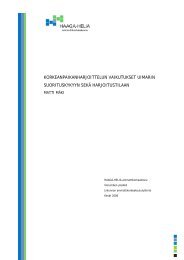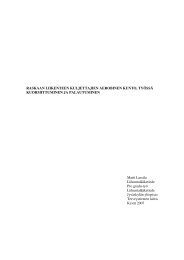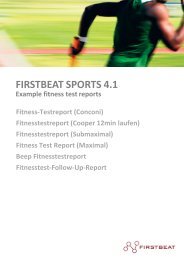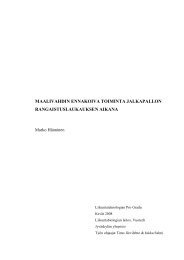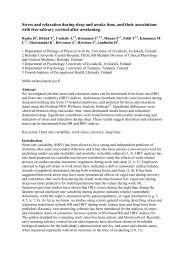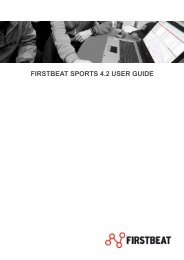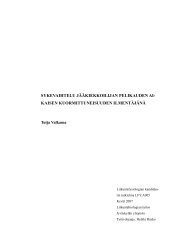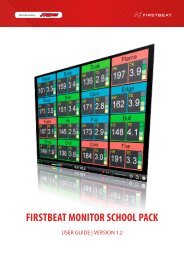Firstbeat SPORTS
Firstbeat SPORTS
Firstbeat SPORTS
You also want an ePaper? Increase the reach of your titles
YUMPU automatically turns print PDFs into web optimized ePapers that Google loves.
<strong>Firstbeat</strong> <strong>SPORTS</strong><br />
Technical Manual -version 3.0.0
2 _____________________________________________________________________<br />
Table of contents:<br />
1 TECHNICAL MANUAL .................................................................................................... 3<br />
1.1 SOFTWARE FEATURES ...................................................................................................... 3<br />
1.2 MINIMUM SYSTEM REQUIREMENTS .................................................................................... 3<br />
1.3 USING FIRSTBEAT <strong>SPORTS</strong> ............................................................................................. 4<br />
1.3.1 Starting <strong>Firstbeat</strong> <strong>SPORTS</strong> for the first time ...................................................................... 4<br />
1.3.1.1 Product activation ................................................................................................................... 4<br />
1.3.1.2 User name and password ........................................................................................................ 6<br />
1.3.1.3 Product registration ................................................................................................................ 7<br />
1.3.1.4 Welcome dialog ...................................................................................................................... 7<br />
1.3.2 Managing profiles ........................................................................................................... 8<br />
1.3.2.1 Change Profile ...................................................................................................................... 13<br />
1.3.2.2 Add profile ........................................................................................................................... 13<br />
1.3.2.3 Profile management .............................................................................................................. 13<br />
1.3.2.4 Profile change history ........................................................................................................... 14<br />
1.3.3 R-R data file management............................................................................................. 15<br />
1.3.3.1 Load R-R file ........................................................................................................................ 15<br />
1.3.3.2 R-R file analysis .................................................................................................................... 18<br />
1.3.3.3 R-R file reanalysis ................................................................................................................. 19<br />
1.3.4 Measurements .............................................................................................................. 19<br />
1.3.4.1 Defining measurement type ................................................................................................... 21<br />
1.3.4.2 Reviewing measurements ...................................................................................................... 21<br />
1.3.4.3 Popup menu on the main view ............................................................................................... 22<br />
1.3.5 File menu ..................................................................................................................... 23<br />
1.3.5.1 Export ................................................................................................................................. 23<br />
1.3.5.2 Import ................................................................................................................................. 25<br />
1.3.5.3 System backup ..................................................................................................................... 25<br />
1.3.5.4 Send by e-mail ..................................................................................................................... 26<br />
1.3.5.5 Check e-mail ........................................................................................................................ 26<br />
1.3.6 Tools menu .................................................................................................................. 26<br />
1.3.6.1 Suunto Smart/Memory Belt Config Tool .................................................................................. 27<br />
1.3.6.2 <strong>Firstbeat</strong> Bodyguard Config Tool ............................................................................................ 28<br />
1.3.6.3 Multianalysis, analyzing multiple measurements ...................................................................... 29<br />
1.3.6.4 Edit Measurements ............................................................................................................... 29<br />
1.3.6.5 Training monitor ................................................................................................................... 31<br />
1.3.6.6 Reestimate recovery index bounds ......................................................................................... 35<br />
1.3.6.7 Options dialog ...................................................................................................................... 35<br />
1.3.7 Group management ...................................................................................................... 37<br />
1.3.7.1 New group ........................................................................................................................... 37<br />
1.3.7.2 Delete group ........................................................................................................................ 37<br />
1.3.7.3 Edit group ............................................................................................................................ 38<br />
1.3.8 Creating reports ........................................................................................................... 38<br />
1.3.8.1 Create report ....................................................................................................................... 38<br />
1.3.8.2 Create group report .............................................................................................................. 41<br />
1.3.8.3 Data analysis report .............................................................................................................. 43<br />
1.3.8.4 Fitness Tests ........................................................................................................................ 45<br />
1.3.8.5 Fitness test browser .............................................................................................................. 54<br />
1.3.8.6 Fitness test follow-up report .................................................................................................. 55<br />
1.3.9 Synchronization ............................................................................................................ 56<br />
1.3.9.1 Setting the options ............................................................................................................... 56<br />
1.3.9.2 Synchronization tool ............................................................................................................. 56<br />
1.3.9.3 Synchronizing profiles ........................................................................................................... 58<br />
_____________________________________________________________________________<br />
Copyright © <strong>Firstbeat</strong> Technologies Ltd.
_______________________________________________________________________<br />
3<br />
1 TECHNICAL MANUAL<br />
1.1 Software features<br />
• <strong>Firstbeat</strong> <strong>SPORTS</strong> produces individual and team reports for monitoring training<br />
load, stress and recovery and fitness level and for creating training programs.<br />
• The collection of IBI data is accomplished by <strong>Firstbeat</strong> <strong>SPORTS</strong> compatible<br />
measurement device.<br />
• R-R data can be extracted directly from Suunto t6/t6c and Smart/Memory Belt<br />
to <strong>Firstbeat</strong> <strong>SPORTS</strong>.<br />
• Automatic error correction removes artefacts and corrects R-R data.<br />
• Customer privacy protection is assured by user authentication during program<br />
start up.<br />
• Profile information enables accurate analysis of R-R data.<br />
• Existing profiles can be updated with reanalysis.<br />
• The customer gets printed feedback thanks to reports in PDF –format (Adobe<br />
Acrobat).<br />
• It is possible to include user defined company name and logo in reports, which<br />
enables creation of individual reports.<br />
1.2 Minimum system requirements<br />
• Compatible with Windows 2000, Windows XP, Windows Vista and Windows<br />
7.<br />
• (Windows ME and 98 are not tested)<br />
• 512MB of RAM.<br />
• 1GHz CPU<br />
• Screen resolution at 1024x768 and 16-bit colours.<br />
• Hard disk drive free space 50MB.<br />
• Adobe Acrobat Reader 5.0 or later.<br />
• Compatible measurement devices:<br />
<strong>Firstbeat</strong> Bodyguard<br />
Suunto t6 & t6c<br />
Suunto Smart/Memory Belt<br />
Suunto PC pod<br />
Suunto Team pod<br />
Polar S810, RS800, RS800CX, CS600<br />
Polar RR -recorder<br />
Polar Vantage<br />
Holter (at least BMS)<br />
Note!<br />
Analysis results require large amounts of hard disk drive depending on the amount of<br />
analyses conducted. 1000 hours of analyzed R-R data takes about 250MB of hard disk<br />
drive space.<br />
_____________________________________________________________________________<br />
Copyright © <strong>Firstbeat</strong> Technologies Ltd.
4 _____________________________________________________________________<br />
1.3 Using <strong>Firstbeat</strong> <strong>SPORTS</strong><br />
1.3.1 Starting <strong>Firstbeat</strong> <strong>SPORTS</strong> for the first time<br />
1.3.1.1 Product activation<br />
<strong>Firstbeat</strong> <strong>SPORTS</strong> features a product activation to protect users’ rights and<br />
prohibit non licensed use of the software.<br />
<strong>Firstbeat</strong> <strong>SPORTS</strong> must be activated before it’s ready for use.<br />
An activation key should have been received with this software. The activation<br />
key is used for activating the <strong>Firstbeat</strong> <strong>SPORTS</strong> product.<br />
There are two ways to do the activation, through Internet or manually. Internet<br />
activation requires an active and fully functional internet connection. Manual<br />
activation does not require an internet connection but it requires use of e-mail.<br />
Program will automatically choose the activation method. If the computer has<br />
access to <strong>Firstbeat</strong> activation server the automatic activation is selected.<br />
Otherwise the manual activation is selected.<br />
Note!<br />
If a firewall software is on use on the computer, it might prompt of new program<br />
trying access Internet. Allow the program to access Internet.<br />
Illustration 1. Internet activation.<br />
Type in the activation key to the field labeled ‘Activation key’, be sure to type it<br />
correctly, it’s recommended to use the clipboard to copy the key to its field.<br />
When activation key has been entered, press button labeled ‘Activate’. If a<br />
firewall software is on use on the computer, it might prompt of new program<br />
trying access Internet. Allow the program to access Internet.<br />
_____________________________________________________________________________<br />
Copyright © <strong>Firstbeat</strong> Technologies Ltd.
_______________________________________________________________________<br />
5<br />
If the internet activation fails, program will shift to the manual activation dialog<br />
as shown below.<br />
Illustration 2. Manual activation, step 1.<br />
To activate the product manually, type in the activation key into the edit field<br />
labelled ‘Key.’<br />
When activation key has been successfully entered into the edit field, press<br />
‘Next’.<br />
Illustration 3. Manual activation, step 2.<br />
At this point, an functional e-mail service has to be in use. Compose a new e-<br />
mail message. Copy & paste the key to the Subject field. Send the e-mail to<br />
fas@firstbeattechnologies.com. E-mail program might prompt for empty body<br />
part of the e-mail message, ignore it and continue to send the e-mail message.<br />
Within few minutes a reply message should be received. The message contains<br />
the user key. Copy & paste it to the edit field labelled ‘Key’.<br />
Having entered the user key, press button ‘Next’. Now the product is activated<br />
and ready to be started.<br />
_____________________________________________________________________________<br />
Copyright © <strong>Firstbeat</strong> Technologies Ltd.
6 _____________________________________________________________________<br />
1.3.1.2 User name and password<br />
When starting <strong>Firstbeat</strong> <strong>SPORTS</strong> after the activation, a username and an<br />
optional password can be specified. Those are used for user authentication<br />
every time the application is started.<br />
Illustration 4. Dialog for entering user name and optional password when<br />
first using the program.<br />
The password can be changed or removed in ‘Tools’ -> ‘Options’ -> ‘Other<br />
settings’.<br />
In case the password has not been previously defined<br />
1. Write the new password to the upper ‘New password’ – field.<br />
2. Repeat the password to the lower ’New password’ –field.<br />
3. Press OK.<br />
When the password is wanted to be changed or removed.<br />
1. Write the old password to its field.<br />
2. When new password is wanted to be created, write it to the empty<br />
fields.<br />
_____________________________________________________________________________<br />
Copyright © <strong>Firstbeat</strong> Technologies Ltd.
_______________________________________________________________________<br />
7<br />
3. If wanted to remove the password, leave the new password fields<br />
empty.<br />
1.3.1.3 Product registration<br />
Illustration 5. Registering <strong>Firstbeat</strong> <strong>SPORTS</strong>.<br />
The product registration is optional but it is strongly recommended. Sign up for<br />
useful <strong>Firstbeat</strong> newsletters to receive information on future product updates<br />
and to use the <strong>Firstbeat</strong> product more efficiently. The newsletters will also<br />
contain training related information.<br />
Fill in the fields with relevant information and press ‘Register product’ to register<br />
and press ‘Cancel’ to continue without registering.<br />
1.3.1.4 Welcome dialog<br />
Welcome dialog appears on the first run of the program. It contains information<br />
on the very basics of the program and how to use its main features. It can be<br />
seen below.<br />
_____________________________________________________________________________<br />
Copyright © <strong>Firstbeat</strong> Technologies Ltd.
8 _____________________________________________________________________<br />
Illustration 6. Welcome dialog.<br />
Clicking the blue links on the left shows information on that topic in the right.<br />
If option ‘Do not show…’ is checked the dialog will not be shown next time the<br />
program is run. The dialog can also be found under the Help menu and it can<br />
be remade to appear on program startup in the Options dialog.<br />
Press button ‘Close’ to exit the dialog.<br />
1.3.2 Managing profiles<br />
One profile refers always to one person and consists of information of that<br />
person’s personal attributes. Basic information is necessary for performing<br />
analysis. The basic information – such as age, weight, height and activity class<br />
affect the estimates and reactions of various physiological variables. More<br />
accurate profile information means more accurate analysis results.<br />
Compulsory profile information includes:<br />
• First name<br />
• Last name<br />
• Date of birth<br />
• Language<br />
• Gender<br />
• Height<br />
• Weight<br />
• Activity class<br />
_____________________________________________________________________________<br />
Copyright © <strong>Firstbeat</strong> Technologies Ltd.
_______________________________________________________________________<br />
9<br />
Illustration 7. Basic profile information is compulsory.<br />
Additional profile information increases the accuracy of analysis. In case some<br />
personal values are unknown, leave the fields empty. The program has default<br />
reference values based on compulsory profile information which are used in<br />
absence of additional profile information.<br />
Additional profile information includes:<br />
• Personal ID (shown in Training Monitor if the alias name is not given)<br />
• Maximum Heart Rate (beats/min)<br />
• Minimum Heart Rate (beats/min)<br />
• METmax (METs) (Oxygen intake measure)<br />
• Vital capacity (l)<br />
• Training endurance classes up to five limits<br />
• Training classification unit: %VO 2 max or %HR max<br />
_____________________________________________________________________________<br />
Copyright © <strong>Firstbeat</strong> Technologies Ltd.
10 _____________________________________________________________________<br />
Illustration 8. Additional profile information can be used to increase accuracy<br />
of analysis and to specify information that is used by other features.<br />
_____________________________________________________________________________<br />
Copyright © <strong>Firstbeat</strong> Technologies Ltd.
_______________________________________________________________________<br />
11<br />
Note!<br />
More information on determining MET-oxygen intake and activity class can be found at<br />
Help menu.<br />
Also personal training monitor information and groups to which person belongs<br />
can be managed in profile management window.<br />
Training monitor profile information includes:<br />
<br />
<br />
<br />
<br />
<br />
Alias name (shown as default in Training Monitor)<br />
E-mail address<br />
Automatic reporting after Training Monitor session is completed<br />
Automatic report e-mailing after Training Monitor session is completed<br />
Variables shown for the profile in Training Monitor Session<br />
Illustration 9. Profile information for the Training Monitor sessions.<br />
Activity class description, user guide and documents, welcome dialog, MET<br />
oxygen consumption and information about TRIMP can be found from Help<br />
menu. Activity class help can also be printed.<br />
_____________________________________________________________________________<br />
Copyright © <strong>Firstbeat</strong> Technologies Ltd.
12 _____________________________________________________________________<br />
Illustration 10. Help menu contains entries for welcome dialog, activity<br />
classes, MET-oxygen intake, TRIMP, user guide and documents.<br />
_____________________________________________________________________________<br />
Copyright © <strong>Firstbeat</strong> Technologies Ltd.
_______________________________________________________________________<br />
13<br />
1.3.2.1 Change Profile<br />
Pressing 'Change Profile' button opens list of available profiles.<br />
1. Open the list by pressing button ’Change Profile’.<br />
2. Click on the name of preferred profile or filter profiles by name or<br />
group and then click on the name of preferred profile.<br />
3. The measurement view updates the display with the selected profile’s<br />
information, measurements and the information of active<br />
measurement.<br />
1.3.2.2 Add profile<br />
Pressing ’Edit profile’ button opens profile management dialog.<br />
1. Press ’Edit profile’.<br />
2. Profile management dialog opens.<br />
3. Press ’Add profile’<br />
4. Enter compulsory information to basic information fields.<br />
5. Input known additional information to additional information fields.<br />
6. Save the information by pressing save.<br />
1.3.2.3 Profile management<br />
Profiles can be added, modified and deleted in profile management. When the<br />
profile management dialog is entered, the currently selected profile is<br />
highlighted on list box that displays all the profiles. The selected profile’s<br />
information is listed on the edit fields on the right.<br />
1. Press ’Edit profile’.<br />
2. Select profile from the list whose information you want to modify.<br />
3. Press ’Edit’ to enable the profile information fields for editing.<br />
4. Press ‘Save’ to save the changes. Pressing ‘Cancel’ discards the changes.<br />
When deleting profile, make sure that the correct profile is selected. The<br />
application asks for confirmation when deleting profiles.<br />
_____________________________________________________________________________<br />
Copyright © <strong>Firstbeat</strong> Technologies Ltd.
14 _____________________________________________________________________<br />
Note!<br />
Deleting a profile also deletes all of the profile’s measurements in the database. The<br />
created PDF reports and heart rate data files will not be removed.<br />
Illustration 11. In the profile management dialog profiles can be added,<br />
deleted and modified.<br />
1.3.2.4 Profile change history<br />
The changes and updates to profile information are listed on the Profile change<br />
history. The Profile change history is placed under the heading ‘View’ in the<br />
main menu.<br />
Information in the profile change history:<br />
• Time (date and time when the change took place)<br />
• Attribute (what variable was changed)<br />
• Old value (the variable value before the change)<br />
• New value (the variable value after the change)<br />
• Event (the source of the change: a manual profile modification or an update<br />
based on an analysis)<br />
• Measurement (start time of the measurement if an analysis was the source of<br />
change)<br />
_____________________________________________________________________________<br />
Copyright © <strong>Firstbeat</strong> Technologies Ltd.
_______________________________________________________________________<br />
15<br />
Note!<br />
Illustration 12. Profile change history lists changes and updates to the profile<br />
information.<br />
1.3.3 R-R data file management<br />
R-R data file means a file containing an inter beat interval (IBI) data series<br />
recorded with R-R recording device (such as Suunto t6/t6c). R-R data recording<br />
devices measure time in milliseconds between consecutive R-peaks in one's<br />
heart beats.<br />
<strong>Firstbeat</strong> <strong>SPORTS</strong> supports following R-R data file formats: .ste, .hrm, .sdf, .csv, .dat,<br />
.bms and .txt file created from FRWD. The file extension does not guarantee that the file<br />
itself is in the right format.<br />
1.3.3.1 Load R-R file<br />
R-R data can be loaded from a file or directly from Suunto t6/t6c and<br />
Smart/Memory Belt measurement devices. The information defined during R-R<br />
data file loading can also be modified later.<br />
1. Select ‘Load R-R file’<br />
2. In opening dialog, select whether to load a file or load the data<br />
directly from <strong>Firstbeat</strong> Bodyguard, Suunto t6/t6c, Suunto<br />
Smart/Memory Belt or Polar s810, RS800, RS800CX or CS600.<br />
3. Optionally measurement type can be specified, is the measurement<br />
exercise, night or daily stress measurement. They can also be<br />
specified later.<br />
4. Optionally the reports to be created from the new measurements can<br />
be selected. In this case the ‘Execute’ button must be pressed, which<br />
triggers analysis and report creation. ‘Execute’ button also closes this<br />
dialog. The reports can also be created later.<br />
5. Press ‘Close’ to exit the R-R file loading tool.<br />
6. When closing the dialog the software may ask if artefact tails from the<br />
end of R-R files are to be removed. Artefact tails are time periods at<br />
the end of the R-R files that contain 100% of measurement errors.<br />
_____________________________________________________________________________<br />
Copyright © <strong>Firstbeat</strong> Technologies Ltd.
16 _____________________________________________________________________<br />
Note!<br />
Illustration 13. When loading R-R files from Suunto t6/t6c or Smart/Memory<br />
Belt, the measurements wanted to be loaded and/or removed from the<br />
device can be chosen.<br />
When loading from devices, <strong>SPORTS</strong> can be set to automatically load from selected<br />
device. Change this from ‘Options’ -> ‘HR data’ -> ‘Load R-R file’.<br />
Suunto devices might sometimes have had interruptions in R-R recording which<br />
appears as multiple short measurements when loading measurements from the<br />
device. If such measurements are loaded from Suunto device, the measurement<br />
merging tool opens, it can be seen in below.<br />
Illustration 14. The measurement merging tool.<br />
The tool opens if it’s enabled in Options dialog and at least two measurement’s<br />
start and end times are closer than the time period defined in Options dialog.<br />
_____________________________________________________________________________<br />
Copyright © <strong>Firstbeat</strong> Technologies Ltd.
_______________________________________________________________________<br />
17<br />
Select the measurements wanted to be merged by checking them on the<br />
‘Merge’ column. Click ‘OK’ to close the dialog and have the selected mergings<br />
done or close the dialog with ‘Cancel’ with no modifications.<br />
If there are duplicate R-R files, they are identified and user is asked what to do.<br />
The following information can be entered for new measurements when loading<br />
R-R files:<br />
• Measurement type (new measurements automatically receive status of<br />
night measurement if they match the night measurement criteria given in<br />
Options dialog)<br />
• Time zone<br />
- Chances the start time of the measurement<br />
• Reports to be created<br />
- Some or all of the available reports can be chosen.<br />
- Selected reports will be created when the ‘Execute’ button is pressed.<br />
• Two different curves<br />
Illustration 15. In the load R-R file dialog, information regarding report<br />
creation can be specified.<br />
If the lowest heart rate in analyzed measurement goes under the value in<br />
profile information, the analysis uses the new found lower value. Otherwise the<br />
value specified in profile information is used. The same applies to the maximum<br />
heart rate. After the analysis the application suggests the new values for max<br />
and/or min HR in profile information.<br />
_____________________________________________________________________________<br />
Copyright © <strong>Firstbeat</strong> Technologies Ltd.
18 _____________________________________________________________________<br />
Measurement’s information can be modified after analysis. Editing of some of<br />
the information will cause the measurement to become outdated and require<br />
reanalysis. Such information is:<br />
• Personal parameters during the measurement<br />
When saving modifications to the personal parameters during the<br />
measurement, the application starts the re-analysis automatically. If this<br />
reanalysis is aborted, the state of the measurement becomes outdated. The<br />
measurement has to be reanalyzed before new reports can be created out of it.<br />
1.3.3.2 R-R file analysis<br />
When analysis begins, a dialog appears displaying the measurements to be<br />
analyzed. The dialog also shows the progress of current measurement and<br />
overall progress of measurements to be analyzed.<br />
After installation of the software, the first analysis calibrates the progress<br />
information to match the computer’s performance.<br />
Illustration 16. The analysis progress is displayed in separate dialog.<br />
_____________________________________________________________________________<br />
Copyright © <strong>Firstbeat</strong> Technologies Ltd.
_______________________________________________________________________<br />
19<br />
1.3.3.3 R-R file reanalysis<br />
The measurement can be reanalyzed if it is outdated or it has not been<br />
previously analyzed. There are two ways to do the reanalysis:<br />
Analyzing single measurement:<br />
1. Select the measurement from the list and press button ’Analyze’.<br />
Analyzing multiple measurements (profile level selection):<br />
1. Open ”Tools” menu.<br />
2. Select item ”Multianalysis”.<br />
3. Checking or unchecking analyzed, outdated or not analyzed<br />
measurements check boxes update the list of available measurements.<br />
4. Select profiles whose measurements wanted to be analyzed.<br />
5. Press ”Analyze”.<br />
1.3.4 Measurements<br />
There are two views in the program: Measurements view and Training History<br />
view. The measurements view of the program is used to manage<br />
measurements of the selected profile. The two panels below the toolbar buttons<br />
display the details of the currently selected profile.<br />
Illustration 17. The Measurements view of <strong>Firstbeat</strong> <strong>SPORTS</strong>.<br />
The measurements table on the Measurements view of <strong>Firstbeat</strong> <strong>SPORTS</strong><br />
displays the loaded R-R files. Columns shown can be selected from the ’Tools‘ -<br />
> ’Options‘ -> ’View‘. Measurements list can also be filtered and grouped. The<br />
measurements table can have following columns:<br />
• Date (start date of the measurement)<br />
_____________________________________________________________________________<br />
Copyright © <strong>Firstbeat</strong> Technologies Ltd.
20 _____________________________________________________________________<br />
Note!<br />
• Start time (start time of the measurement)<br />
• Duration (the duration of the measurement)<br />
• Measurement type (see section 1.3.4.1)<br />
• Analysis state<br />
- Analyzed<br />
- Not analyzed<br />
- Outdated<br />
• Error percentage<br />
• File name<br />
• Notes<br />
• Height<br />
• Weight<br />
• Activity class<br />
• Energy expenditure<br />
• Highest heart rate<br />
• EPOC peak<br />
• Training Effect<br />
The measurement information button displays three different tabs.<br />
The measurement information tab displays general information on the currently<br />
selected, active, measurement (the measurement selected on the<br />
measurements table).<br />
The profile information tab displays the personal parameters that applied during<br />
the measurement.<br />
Profile information can be modified if some of the earlier values have changed<br />
such as min HR decreased or weight increased.<br />
Each measurement has information of the person profile parameters that were<br />
valid during the measurement. Those parameters can be changed. After such<br />
modification the measurement becomes outdated and must be reanalyzed.<br />
Measurement information and profile information can also be set and modified<br />
for multiple measurements simultaneously.<br />
Profile information at the time of the measurement represents the profile information<br />
during the start time of the measurement, while the profile information in profile<br />
management dialog stands for the current, today’s, profile information. When a new<br />
R-R file is loaded and new measurement is created, the new measurement’s profile<br />
information is based on the current profile information.<br />
The bottom part of the measurements view shows different charts (HR and<br />
EPOC as default), physiological state overview and endurance training<br />
classification. Possible charts are:<br />
<br />
<br />
<br />
<br />
Heart rate<br />
EPOC + TE<br />
%VO2max<br />
Distance<br />
_____________________________________________________________________________<br />
Copyright © <strong>Firstbeat</strong> Technologies Ltd.
_______________________________________________________________________<br />
21<br />
<br />
<br />
<br />
<br />
<br />
Respiration<br />
Altitude<br />
Speed<br />
Energy Expenditure<br />
Cadence<br />
Also lap times are shown in the measurement’s view graphs.<br />
If multiple analyzed measurements are selected on the measurements view,<br />
follow-up charts are shown for these measurements in the bottom part. There<br />
are three different follow-up charts: Training durations on different training<br />
types, EPOC peak values and recovery index.<br />
1.3.4.1 Defining measurement type<br />
Defining measurement type helps to remember the kind of measurement and<br />
makes finding certain types of measurements faster. It is possible to create own<br />
measurement types in the options dialog:<br />
1. Select ’Tools’ → ’Options’ → ’HR data’ → ’Measurement types’<br />
2. Press ’Add new’ on measurement types<br />
3. Type the name of the measurement type on the empty field<br />
4. Press ’Save’<br />
5. Press ’Apply’<br />
1.3.4.2 Reviewing measurements<br />
The measurement view of <strong>Firstbeat</strong> <strong>SPORTS</strong> enables viewing of measurement’s<br />
belonging to the selected profile. The measurement view displays information<br />
on measurements such as some HR related figures, different charts,<br />
physiological state overview and endurance training classification.<br />
1. Click on the measurement on the measurements table.<br />
2. Information of the selected measurement is displayed and<br />
measurement chart is shown in the bottom of the screen. Different<br />
charts, physiological state overview or endurance training classification<br />
can be selected to be shown by changing the tab selection.<br />
3. With the HR chart the style how the chart is drawn can be chosen. Use<br />
the check boxes to change the view.<br />
_____________________________________________________________________________<br />
Copyright © <strong>Firstbeat</strong> Technologies Ltd.
22 _____________________________________________________________________<br />
Note!<br />
Illustration 18. The HR chart can be viewed with artifact correction and<br />
averaged HR series enabled or disabled.<br />
The HR chart can be zoomed by holding down left mouse button and moving mouse to<br />
right and down, the zoom is reset by holding down left mouse button and moving mouse<br />
to up and left. The chart can be scrolled by holding down right mouse button and moving<br />
mouse over the chart.<br />
1.3.4.3 Popup menu on the main view<br />
The measurements table features a pop up menu that can be invoked by<br />
clicking the table with right mouse button. The pop up contains actions for<br />
selected measurements on the table:<br />
• Analyze<br />
• Report creation<br />
• Measurement export<br />
• Editing measurement info for all selected measurements<br />
• Deleting measurements<br />
• Sending measurements<br />
• Edit measurements<br />
Multiple measurements can be selected by holding down Control and clicking on<br />
the measurements table.<br />
_____________________________________________________________________________<br />
Copyright © <strong>Firstbeat</strong> Technologies Ltd.
_______________________________________________________________________<br />
23<br />
Illustration 19. Popup menu of measurements table.<br />
1.3.5 File menu<br />
From file menu new R-R file can be loaded and measurements can be sent and<br />
received using e-mail. File menu also contains the tools to create backup files of<br />
the <strong>SPORTS</strong>.<br />
Illustration 20. File menu.<br />
1.3.5.1 Export<br />
There are five ways of export: the data export, the measurement export, the<br />
multimeasurement export, the master export and the person profile export.<br />
With the data export you can save measurements in csv file. The measurement<br />
export saves the chosen measurement. In the multimeasurement export several<br />
measurements can be selected to be exported. The master export saves all the<br />
measurements and the profile information. The person profile export saves only<br />
the profile info, not any measurements. (See more information in export dialog,<br />
illustration 21.)<br />
In the measurement and master export the only step is to define the folder<br />
were the program saves the data. In addition to that also measurements to be<br />
exported have to be chosen in the measurement export. In the person profile<br />
export the program asks which profiles are wanted to be saved. After selection<br />
press ‘Save’ to complete the export.<br />
_____________________________________________________________________________<br />
Copyright © <strong>Firstbeat</strong> Technologies Ltd.
24 _____________________________________________________________________<br />
Illustration 21. There are five ways to export in <strong>Firstbeat</strong> <strong>SPORTS</strong>.<br />
_____________________________________________________________________________<br />
Copyright © <strong>Firstbeat</strong> Technologies Ltd.
_______________________________________________________________________<br />
25<br />
1.3.5.2 Import<br />
The exported data can be loaded to the program with the import tool. Pressing<br />
‘Import’ opens a folder selection. Simply choose the folder where the wanted<br />
data is and press ‘Open’.<br />
Illustration 22. Choosing the imported file.<br />
1.3.5.3 System backup<br />
System backup can be created to ensure that no data will be lost in case of a<br />
system or a program failure. System backup saves all the data from <strong>SPORTS</strong>,<br />
including the profiles, measurements and settings.<br />
Illustration 23. System backup dialog.<br />
By clicking system backup in file menu invokes a selection whether to create or<br />
restore a backup file. Choosing to create a backup file, next step is to define the<br />
_____________________________________________________________________________<br />
Copyright © <strong>Firstbeat</strong> Technologies Ltd.
26 _____________________________________________________________________<br />
folder where the program saves the backup. After selection press ‘Execute’ to<br />
make the backup.<br />
If wanted to load a backup, choose ‘Restore from backup’. Next choose the file<br />
from where the backup data is wanted to be loaded. Next press ‘Execute to<br />
restore the data’.<br />
1.3.5.4 Send by e-mail<br />
The selected measurements can be sent using e-mail. E-mail settings can be<br />
determined by clicking ’Tools‘ -> ’Other settings‘ -> ’E-mail settings’.<br />
1. Select one or more measurements from the Measurements list.<br />
2. Choose ‘File‘ -> ’Send by e-mail‘. If e-mail settings have not been<br />
determined, e-mail settings tab of the settings dialog opens.<br />
3. Write e-mail address to which measurements are sent and click ’OK’.<br />
1.3.5.5 Check e-mail<br />
You can check if any measurements have arrived to your e-mail by choosing<br />
‘Check e-mail’ from the file menu. Arrived measurements can be read to the<br />
system. E-mail settings can be determined in ’Tools‘ -> ’Other settings‘ -> ’Email<br />
settings’.<br />
E-mail feature is especially useful when several <strong>Firstbeat</strong> softwares are used to<br />
collect and analyze HR data but all measurements is wanted to be kept<br />
centralized in one application. In this kind of situation it is recommended to<br />
create a new e-mail account for the main application and determine that e-mail<br />
account into the program’s settings. When this is done, selected measurements<br />
can be sent by e-mail from other <strong>Firstbeat</strong> applications to the main application.<br />
Personal parameters and identification information used in measurements are<br />
sent in addition to the measurement information. When measurements are<br />
received, <strong>SPORTS</strong> checks if personal information of received profile has already<br />
been created. If personal profile has been determined, <strong>SPORTS</strong> suggests the<br />
measurement to be added to the user profile. Otherwise, it is suggested to add<br />
a new profile. If same measurements are brought to existing profile, system<br />
asks if duplicates are formed. Measurements are interpreted to be duplicates if<br />
start time and duration of the measurement are same. Person is recognized<br />
based on name and date of birth.<br />
1.3.6 Tools menu<br />
Tools menu contains tools for advanced features.<br />
_____________________________________________________________________________<br />
Copyright © <strong>Firstbeat</strong> Technologies Ltd.
_______________________________________________________________________<br />
27<br />
Illustration 24. Tools menu contains tools for advanced features.<br />
1.3.6.1 Suunto Smart/Memory Belt Config Tool<br />
The Suunto Smart/Memory Belt Config Tool offers means to configure the<br />
Suunto Smart/Memory Belt. Following options can be configured:<br />
• Synchronizing belt internal clock to PC’s clock (manually or automatically<br />
when belt is connected)<br />
• Turning belt tones on/off<br />
• Turning radio transmission on/off (turning the radio transmission off saves<br />
the battery)<br />
• Turning R-R recording on/off<br />
• Memory full warning limit percentage (warning is given, when free memory<br />
is below this limit)<br />
• Number of free logs low warning limit (warning is given, when number of<br />
free logs is below this limit)<br />
• Identifier string for the belt<br />
_____________________________________________________________________________<br />
Copyright © <strong>Firstbeat</strong> Technologies Ltd.
28 _____________________________________________________________________<br />
Illustration 25. Suunto Smart Belt Config Tool enables configuration of Smart<br />
Belt.<br />
Synchronize the belt’s internal clock to PC’s date and time by pressing button<br />
‘Sync belt time now’.<br />
Save the new configuration by pressing button ‘Save’ or close the tool with<br />
button ‘Cancel’.<br />
1.3.6.2 <strong>Firstbeat</strong> Bodyguard Config Tool<br />
The <strong>Firstbeat</strong> Bodyguard Config Tool offers means to configure the <strong>Firstbeat</strong><br />
Bodyguard. Following options can be configured:<br />
• Synchronizing Bodyguard internal clock to PC’s clock (manually or<br />
automatically when Bodyguard is connected)<br />
• Turning Bodyguard voltage alarm on/off<br />
• Turning Bodyguard memory level alarm on/off<br />
• Battery voltage warning limit percentage (warning is given, when battery<br />
voltage is below this limit)<br />
• Memory full warning limit percentage (warning is given, when free memory<br />
is below this limit)<br />
• Time when Bodyguard is shut down when it is not measuring<br />
• Identifier string for the Bodyguard<br />
_____________________________________________________________________________<br />
Copyright © <strong>Firstbeat</strong> Technologies Ltd.
_______________________________________________________________________<br />
29<br />
• Time zone for the Bodyguard<br />
Illustration 26. <strong>Firstbeat</strong> Bodyguard Config Tool enables configuration of<br />
Bodyguard.<br />
Synchronize the Bodyguard’s internal clock to PC’s date and time by pressing<br />
button ‘Sync time now’.<br />
Save the new configuration by pressing button ‘Save’ or close the tool with<br />
button ‘Cancel’.<br />
1.3.6.3 Multianalysis, analyzing multiple measurements<br />
If necessary, all measurements can be reanalyzed by multianalysis tool. It<br />
allows analysis of measurements of several persons. Re-analysis is required for<br />
example after updating the software to a new version (in that case all<br />
measurements will have state ‘outdated’). In multianalysis tool it is possible to<br />
filter measurements out or in according to the state of the measurements. The<br />
possible states are analyzed, not analyzed and outdated. The number in braces<br />
after a profile’s name indicates the amount of the profile’s measurements to be<br />
re-analyzed.<br />
1. Select ‘Tools’ -> ‘Multianalysis’<br />
2. Select profiles whose measurements wanted to be reanalyzed<br />
3. Press ‘Analyzed’<br />
1.3.6.4 Edit Measurements<br />
Measurements can be edited either by merging or splitting them. It can be<br />
made from the tools menu but the tool can also be invoked by pressing the<br />
_____________________________________________________________________________<br />
Copyright © <strong>Firstbeat</strong> Technologies Ltd.
30 _____________________________________________________________________<br />
right mouse button on the top of the wanted measurement and selecting ‘Edit<br />
measurement’ from the pop up menu.<br />
Illustration 27. Edit measurements is also located at pop up menu.<br />
Any measurement shown at the measurements list can be split. Splitting is done<br />
by first activating the wanted measurement by clicking it on the measurement<br />
list at the measurement view. Next start the splitting tool from the pop up menu<br />
or from the tools menu.<br />
Illustration 28. Splitting tool dialog.<br />
At the top of the splitting tool the original measurement is shown. There are<br />
two ways to define the wanted split, either with sliders or by defining the time.<br />
Sliders are simply moved to the start and to the end point of the wanted area.<br />
Another way is to directly type the wanted time period to the time boxes.<br />
After selecting is made press ‘Create new’ to split the measurement.<br />
_____________________________________________________________________________<br />
Copyright © <strong>Firstbeat</strong> Technologies Ltd.
_______________________________________________________________________<br />
31<br />
At the lower ‘New measurements’ box the information of the split sections is<br />
shown. At the lower left side can be seen the start time, end time and the<br />
duration of the new created measurement and at the lower right side the draft<br />
of the new measurement.<br />
The number of new measurements created from the original is not limited, but<br />
every new measurement has to be longer than two minutes.<br />
If the measurement is longer than 12 hours it can be split into twelve hour<br />
section by pressing ‘Split to 12 hours parts…’.<br />
Illustration 29. Merging dialog.<br />
Merging happens by choosing two measurements to be merged from the<br />
measurement list at measurement view. After selection press ‘Merge’ from the<br />
‘Edit measurement’ options. At the merging dialog the program shows the draft<br />
of the new measurement. Measurement type and the notes can be defined at<br />
the merging tool.<br />
If the merging is successfully done from the original two measurements, the<br />
merged measurements will be deleted from the measurement list.<br />
Measurements cannot be merged is they are over 24h apart.<br />
1.3.6.5 Training monitor<br />
Training monitor is a tool for monitoring group up to 30 people at the same<br />
time. Team coaches can use the monitor to follow the performance of their<br />
athletes during the training. Also gyms can use Training Monitor in group<br />
exercises. Suunto team pod, Suunto PC pod or Acentas BM-USBRX3 is required<br />
to operate the training monitor.<br />
The following measures can be monitored with Training Monitor:<br />
_____________________________________________________________________________<br />
Copyright © <strong>Firstbeat</strong> Technologies Ltd.
32 _____________________________________________________________________<br />
• HR<br />
• EPOC<br />
• EPOCpeak<br />
• %VO2max<br />
• %HRmax<br />
• TE<br />
• kcal(sum)<br />
• TRIMP<br />
Up to four of the measures can be monitored at the same time.<br />
How to start Training Monitor?<br />
<br />
<br />
Press green Training Monitor icon in the upper part of the measurement<br />
view, or<br />
Go to ‘Tools’ -> ‘Training Monitor’<br />
When starting the Training Monitor the Training Monitor dialog lists all the belts<br />
that are in the receivers range. The list shows the belts’ ID numbers and the<br />
heart rate the belt is measuring at that moment. -1 signifies either connection<br />
problems or belt has moved out of the range of receiver. <strong>SPORTS</strong> can also be<br />
started to directly to Training monitor.<br />
Preparations before exercise<br />
1. Link profile and belt according to the belt ID found at the backside of<br />
the belt. At least one person has to be selected from the drop down list.<br />
Profiles can also be filtered by group to ease the profile selection. If belt<br />
does not have Profile selected it cannot be displayed<br />
<br />
<br />
If an athlete does not have profile in the <strong>Firstbeat</strong> <strong>SPORTS</strong>, it is<br />
possible to add one by pressing the ‘Add profile’ button.<br />
New user can also be created to Training Monitor in the middle<br />
of a monitoring session, see below.<br />
2. Select ‘Remember’ check box in order to link belt and profile next time<br />
the Training Monitor is used.<br />
3. Select variables which Training Monitor should display during exercise.<br />
Up to four measures can be chosen for multiple persons. The order of<br />
the measures can be changed at the right by dragging them with<br />
mouse.<br />
<br />
Variables shown for specific person can be selected also from the<br />
Training Monitor tab of Profile Information.<br />
4. Press ‘Start monitoring’ when you are ready.<br />
_____________________________________________________________________________<br />
Copyright © <strong>Firstbeat</strong> Technologies Ltd.
_______________________________________________________________________<br />
33<br />
Illustration 30. Training monitor dialog.<br />
Training Monitor main view<br />
The training monitor displays the selected measures for the profiles. Different<br />
displays can be browsed by using interleafs below the screen.<br />
If %VO 2 max measure is selected, it shows color indicating type of endurance<br />
training. There can be up to five limits which can be determined in Profile<br />
Information. The colors of different endurance training areas are explained at<br />
the bottom of the screen.<br />
Timer is shown all the time and can be used to observe duration of the<br />
exercise. Timer includes lap time option.<br />
_____________________________________________________________________________<br />
Copyright © <strong>Firstbeat</strong> Technologies Ltd.
34 _____________________________________________________________________<br />
If ‘Add new devices automatically’ is selected, Training Monitor adds those belts<br />
which are already attached to specific profile automatically in Training Monitor.<br />
Pressing ‘Manage profiles’ displays all belts in the receivers range during the<br />
measurement. Monitored users can be added to and removed from Training<br />
Monitor in the middle of the monitoring session.<br />
Training monitor automatically interpolates R-R data when there is a connection<br />
problem with the belt.<br />
Press ‘Stop’ button to stop monitoring and collecting data from belts.<br />
Illustration 30. Training monitor main view.<br />
Exercise termination<br />
When monitoring is stopped, program shows the collected measurements for<br />
each athlete. Select the measurements by clicking check boxes that will be<br />
saved. Each chosen measurement is saved to selected athlete’s profile. Notes<br />
can be given for measurements after a Training Monitor session has been<br />
completed. These notes will be shown in each saved measurement. When<br />
ready, press ‘OK’ and analysis is done.<br />
_____________________________________________________________________________<br />
Copyright © <strong>Firstbeat</strong> Technologies Ltd.
_______________________________________________________________________<br />
35<br />
Note!<br />
Illustration 31. Saving dialog.<br />
If Suunto Smart/Memory Belt is used, it is not worth saving measurements with<br />
extremely high artefact percentages (more than 60%). Instead it is recommended to<br />
load those measurements from the belts.<br />
There are automatic functions after a Training Monitor session has been<br />
completed:<br />
<br />
<br />
<br />
Fitness report is created and printed using the default printer<br />
Fitness report and measurement export file are sent by e-mail<br />
Training Effect Group report is created from all measurements<br />
Fitness report settings can be turned on/off for every profile from profile<br />
management, see 1.3.2, and Training Effect Group report from the Options<br />
dialog, see 1.3.6.7.<br />
1.3.6.6 Reestimate recovery index bounds<br />
Recovery test detects automatically individual scale for the recovery status<br />
based on the user’s measurement history. These bounds can be re-estimated by<br />
selecting ’Tools‘ -> ’Reestimate recovery bounds‘.<br />
1.3.6.7 Options dialog<br />
In options dialog various preferences and settings can be defined and make<br />
<strong>Firstbeat</strong> <strong>SPORTS</strong> easier to use, such as:<br />
HR data<br />
_____________________________________________________________________________<br />
Copyright © <strong>Firstbeat</strong> Technologies Ltd.
36 _____________________________________________________________________<br />
• HR chart drawing preferences<br />
• Managing measurement types<br />
• Load R-R file dialog preferences<br />
• Choosing physiological state overview states<br />
Reports<br />
• Prompting for report specific options<br />
• Opening reports after creation (on/off)<br />
• Entering user defined text and logo for report footer<br />
Team Feature<br />
• Specifying how linking profiles with Suunto devices is handled<br />
Journal<br />
• Marker types<br />
• Sleep period determination<br />
License<br />
• Entering new license<br />
• Viewing user statistics<br />
• When license is about to expire, information is provided from where a new<br />
license can be obtained.<br />
View<br />
• Columns shown in the measurements table<br />
• Grouping and filtering the measurements<br />
Training monitor<br />
• Selection of default printer<br />
• Background image selection<br />
• Automatic Training Effect Group Report creation (on/off)<br />
• Automatically find and monitor new belts during monitoring (on/off)<br />
Other settings<br />
• Change password<br />
• Show welcome dialog<br />
• Change <strong>Firstbeat</strong> files folder location<br />
_____________________________________________________________________________<br />
Copyright © <strong>Firstbeat</strong> Technologies Ltd.
_______________________________________________________________________<br />
37<br />
Illustration 32. In options dialog various preferences and settings can be<br />
defined.<br />
1.3.7 Group management<br />
In the group management, groups can be added, deleted and modified.<br />
Forming groups makes measurement selection faster in group reporting.<br />
1.3.7.1 New group<br />
1. Press button ’New group’.<br />
2. Enter name for the group.<br />
3. Add profiles to the group by selecting them on the ‘Other profiles’ list<br />
and pressing ‘Add’ button (another way is to double click the person<br />
name). The reverse can be done with button ‘Remove’.<br />
4. Press Save.<br />
1.3.7.2 Delete group<br />
1. Select the group wanted to be delete on list labelled ‘Group<br />
management’.<br />
2. Press button ‘Delete group’.<br />
_____________________________________________________________________________<br />
Copyright © <strong>Firstbeat</strong> Technologies Ltd.
38 _____________________________________________________________________<br />
1.3.7.3 Edit group<br />
1. Select the group wanted to be edited on list labelled ‘Group<br />
management’.<br />
2. Press button ‘Edit’.<br />
3. Add and remove profiles on the group.<br />
4. Press button ‘Save’.<br />
1.3.8 Creating reports<br />
1.3.8.1 Create report<br />
Personal reports can be created directly during R-R file load or afterwards as<br />
follows:<br />
1. Select appropriate person profile.<br />
2. Press ’Create report’.<br />
3. Select measurements from which wanted to be created reports.<br />
4. Select the reports wanted to be created.<br />
5. Select curves to be shown (only Training Report)<br />
6. Press ‘Create reports…’<br />
7. A file saving dialog opens, choose file name prefix and destination<br />
folder.<br />
8. The reports open into the default .PDF viewer. If .PDF viewer is not in<br />
use, download and install one. Adobe Acrobat Reader is<br />
recommended.<br />
_____________________________________________________________________________<br />
Copyright © <strong>Firstbeat</strong> Technologies Ltd.
_______________________________________________________________________<br />
39<br />
Note!<br />
The default folder for saving reports is:<br />
C:\<strong>Firstbeat</strong> Files\Profile name\Individual reports<br />
The report saving folder can be changed in Options dialog’s Other settings tab.<br />
Illustration 33. Create reports dialog is used for personal reporting.<br />
Four different reports can be created: Training Report, Daily Stress Report,<br />
Recovery Test Report and Fitness Report.<br />
Lap times from Suunto t6/t6c and Polar devices are shown also in Training<br />
report in addition to measurement’s view graphs and are loaded into journal.<br />
Recovery Test Report focuses on the first four hours of sleep and can be only<br />
made from measurements with status of night measurement. Recovery test<br />
results are scaled individually based on measurement history. When creating<br />
the report at first time, program opens questionnaire dialog where subjective<br />
feeling and training load is asked. Query dialog is performed to calibrate<br />
recovery scale individually. After having adequate measurement history, the<br />
recovery scale is formed automatically.<br />
Sleep period is defined to start automatically at 11 pm. Sleep time starts an half<br />
hour after set time if measurement starts before the set time. If measurement<br />
_____________________________________________________________________________<br />
Copyright © <strong>Firstbeat</strong> Technologies Ltd.
40 _____________________________________________________________________<br />
starts after the set time, sleep period is set to start an half hour after beginning<br />
of the measurement.<br />
You can redefine time when the sleep time starts from options:<br />
1. Click from upper menu bar ‘tools’ ‘options’<br />
2. Select ‘journal’ and then you can redefine time when the sleep period starts<br />
You can set sleeping time also manually by click ‘tools’ ‘specify sleep periods<br />
for the measurements’<br />
From tools menu you can also re-estimate recovery index bounds.<br />
Illustration 34 a. Questionnaire dialog for describing your feelings.<br />
Illustration 35 b. Sleep time selection for Recovery Test Report.<br />
If sleeping time is not specified, the system default is used. By default, system<br />
supposes sleeping starting 30 minutes after the measurement start and lasting<br />
for 4 hours.<br />
_____________________________________________________________________________<br />
Copyright © <strong>Firstbeat</strong> Technologies Ltd.
_______________________________________________________________________<br />
41<br />
1.3.8.2 Create group report<br />
Training effect group report compares various exercise related properties<br />
between selected measurements such as EPOC and training effect.<br />
1. The Select measurements tree view shows all person profiles that have<br />
analyzed measurements.<br />
2. Expand a node by clicking the + sign on left of a profile’s name. The<br />
node expands to display the profile’s measurements under the profile’s<br />
name.<br />
3. The table on the right displays the selected measurements. The<br />
selected reports are created based on these measurements.<br />
4. Move measurements from the tree view to the table by double clicking<br />
a profile’s name to have all of its measurements moved to the table, or<br />
expand profile’s measurements on the tree view and double click<br />
single measurements.<br />
5. Also multiple profiles can be selected and measurements on the tree<br />
viewed by holding Control and pressing left mouse button. Press<br />
button ‘Add’ to move the selected profiles and measurements from the<br />
tree view to the table.<br />
6. Measurements can be moved back to the tree view from table by<br />
selecting them on the table and pressing button ‘Remove’.<br />
7. The profiles displayed on the tree view can be filtered by selecting<br />
desired group on the drop down list. If done so, only selected group’s<br />
profiles and measurements will be displayed on the tree view.<br />
8. The profiles and measurements on tree view can also be filtered by<br />
the start date of the measurement. Enable the filtering by checking<br />
the ‘Period of time’ check box and specifying desired time period.<br />
Measurements can be also filtered by selecting a measurement type.<br />
9. Select the group reports wanted to be created.<br />
10. Press ‘Create reports…’<br />
11. A file saving dialog opens, choose file name prefix and destination<br />
folder.<br />
The groups of measurements from which group reports have been created are<br />
archived and listed on the ‘Previous group reports’ tab. The tab has a table with<br />
row for each created group report. Double clicking a row moves the<br />
measurements a previous group report to the table ‘Selected<br />
_____________________________________________________________________________<br />
Copyright © <strong>Firstbeat</strong> Technologies Ltd.
42 _____________________________________________________________________<br />
measurements’.<br />
Illustration 36. Group report can be created from the analyzed<br />
measurements.<br />
The Training Effect Group Report shows training effect of each selected<br />
measurement. In case there was set target for training effect, report shows that<br />
target to ease the recognition the diverging measurements more easily. Set the<br />
training effect limits in the dialog shown below.<br />
Illustration 37. Defining training effect limits for Training Effect Group<br />
Report.<br />
_____________________________________________________________________________<br />
Copyright © <strong>Firstbeat</strong> Technologies Ltd.
_______________________________________________________________________<br />
43<br />
Enter the limits and press OK.<br />
1.3.8.3 Data analysis report<br />
General chart of the chosen measurement and variables produced by analysis in<br />
graphical mode can be examined using data analysis report. The measurement<br />
can be treated as a whole or split into shorter periods. PDF-report can be made<br />
from selected variables during the wanted period.<br />
Charts that can be selected to the data analysis report include:<br />
<br />
<br />
<br />
<br />
<br />
<br />
General chart<br />
Artifact corrected heart rate<br />
Artifact corrected R-R interval<br />
Respiration rate<br />
Ventilation<br />
EPOC<br />
VO 2<br />
VO 2 max %<br />
<br />
<br />
<br />
Energy expenditure<br />
Fat % expenditure<br />
Cumulative exercise induced (net) energy expenditure<br />
Creating data analysis report<br />
1. Start data analysis report by choosing ’Reports‘ -> ’Data Analysis Report’<br />
2. You can examine different charts by choosing the wanted variable from<br />
the ’Chart‘ menu.<br />
3. If you want to select certain period instead of the whole measurement,<br />
set cursors to the right places. The new temporary measurement period<br />
is analyzed from the selected time period and reports are created from<br />
that period. The temporary measurement period is not saved.<br />
4. If you want to create a report, choose charts presented in data analysis<br />
report from the data analysis report tab one by one or select all.<br />
5. Press ’Create report’.<br />
6. Select destination and name the report.<br />
7. Press ’Save’.<br />
_____________________________________________________________________________<br />
Copyright © <strong>Firstbeat</strong> Technologies Ltd.
44 _____________________________________________________________________<br />
Illustration 38. You can select several charts from the chosen time period to<br />
the Data Analysis Report.<br />
In addition to data analysis report, you can also create basic reports in the<br />
reports tab.<br />
Creating a report in the data analysis window.<br />
1. Select language, reports and curves shown in the training chart.<br />
2. Press ’Create reports’.<br />
3. Select destination and press ’OK’.<br />
_____________________________________________________________________________<br />
Copyright © <strong>Firstbeat</strong> Technologies Ltd.
_______________________________________________________________________<br />
45<br />
Illustration 39. Also basic reports can be created using data analysis tool.<br />
1.3.8.4 Fitness Tests<br />
The fitness test reports can be accessed from the Fitness Tests menu from the<br />
main toolbar. First select the type of the fitness test report wanted to be<br />
created.<br />
There are seven different types of fitness test reports available:<br />
• Conconi<br />
• WHO<br />
• 20-MST<br />
• Maximal test<br />
• Submaximal test<br />
• UKK walk test<br />
• Cooper test<br />
The fitness test reports each have varying wizards with which they are<br />
specified. But they all share two steps: selecting measurements and time<br />
period.<br />
The first step in all fitness test reports is to select the measurements of which<br />
fitness test reports are to be created. It is visible after selecting the appropriate<br />
type of fitness test report. It can be seen in the illustration below.<br />
_____________________________________________________________________________<br />
Copyright © <strong>Firstbeat</strong> Technologies Ltd.
46 _____________________________________________________________________<br />
Illustration 40. Measurement selection for fitness test reports.<br />
In the first step, select measurements of which wished to generate fitness test<br />
reports from. All analyzed measurements are listed on tree view on the left.<br />
They can be filtered by selecting specific group and by specifying period of time<br />
to show only measurements from desired period.<br />
Select measurements from the tree view and click button ‘Add’, or double click<br />
the measurements. The table on right displays the selected measurements.<br />
Measurements can be removed from the table by selecting them and clicking<br />
button ‘Remove’ or double clicking them.<br />
Journal markers are shown in all fitness test reports’ time period selection step.<br />
The steps to follow after first are explained in the following chapters for each<br />
fitness test report.<br />
Conconi fitness test report<br />
Illustration 37. Protocol definition for Conconi fitness test report.<br />
_____________________________________________________________________________<br />
Copyright © <strong>Firstbeat</strong> Technologies Ltd.
_______________________________________________________________________<br />
47<br />
After selecting the measurements, Conconi fitness test report wizard has<br />
protocol specification step. There are default protocols for running and bicycling<br />
or a new one can be made.<br />
If a new protocol is chosen to be created, press ‘Add new’. Type the name to<br />
the ‘Protocol name’ box. Drop down list ‘Discipline’ displays some pre-defined<br />
disciplines that affect the formula of VO2max calculation.<br />
Group box ‘Workload’ specifies the starting workload at the first stage of the<br />
test, increment after each workload and the unit used to define the workloads.<br />
‘Duration’ group box defines how long each stage lasts. The duration can be<br />
given in time or in distance. Distance can be selected only when workload unit<br />
is km/h.<br />
Averages calculation duration specifies time at the end of the each stage from<br />
which the stage heart rate average is calculated.<br />
When the protocol values are valid, press ‘Save’ and proceed to the next step.<br />
Illustration 38. Time period selection for Conconi fitness test report.<br />
In the third step select the start and end times of the testing for each<br />
measurement.<br />
Select the measurements from the table on left one by one select the test<br />
period using the two sliders below the HR graph or type in the start and end<br />
times in the edit fields below the sliders.<br />
Each measurement will have certain number of stages depending on the<br />
defined protocol and the length of the time period. The number of stages may<br />
not exceed 50. Measurements with over 50 stages are shown red on the left<br />
side table. To next step cannot be moved until all measurements have less than<br />
51 stages.<br />
After all measurements have testing time period selected, proceed to the final<br />
step.<br />
_____________________________________________________________________________<br />
Copyright © <strong>Firstbeat</strong> Technologies Ltd.
48 _____________________________________________________________________<br />
Illustration 39. Details of Conconi fitness test report.<br />
The final step lists all measurements on the table on left. If deflection point for<br />
a measurement can not be calculated automatically, it is shown red on the<br />
table. All measurements must have valid deflection point before reports can be<br />
created. If deflection point cannot be calculated for one or more measurements<br />
move back to the step 1 with ‘Previous’ button and discard those<br />
measurements.<br />
Group box ‘Edit values’ shows details of the report to be generated.<br />
The graph displays HR on the vertical axis and stage number of the horizontal<br />
axis. The white dots indicate HR average of the last user defined time period of<br />
each stage. Red dot indicates hear rate deflection point. The red line is the<br />
linear regression line used on deflection point calculation.<br />
The formula of the linear regression line is shown below the graph. Below that<br />
there is formula for VO2max calculation. VO2max is not calculated if a<br />
predefined formula does not exist for the given discipline and protocol. The<br />
constant in the formula can be edited.<br />
The correlation coefficient for the linear regression line is shown below the<br />
VO2max formula.<br />
Intensity limits are shown below the correlation coefficient. They can also be<br />
edited.<br />
The table on the right lists all stages. The columns have following meanings:<br />
• Number of stage<br />
• Workload at the start of the stage<br />
• Time spent to complete the stage<br />
• Average HR over the specified time (e.g. 30s) at the end of a stage<br />
• Check box determining whether the stage is used in deflection point<br />
calculation or not<br />
The deflection point stage is shown red on the table. It can be moved up or<br />
down with the red arrows at the below.<br />
Initiate report creation by pressing ‘Create reports’.<br />
_____________________________________________________________________________<br />
Copyright © <strong>Firstbeat</strong> Technologies Ltd.
_______________________________________________________________________<br />
49<br />
WHO fitness test report<br />
WHO fitness nest report is a sub maximal cycle ergo meter fitness test.<br />
Having selected desired measurements in the first step, WHO fitness test wizard<br />
has protocol definition step as second. It can be seen below.<br />
Illustration 40. protocol definiton step of WHO fitness test wizard.<br />
Choose the default protocol or create a new one. If wanted to create a new<br />
protocol press ‘Add new’. Group box ‘Workload’ specifies the starting workload<br />
at the first stage of the test and increment after each workload. Other details of<br />
WHO protocol are fixed. Press ’Save’ and move to the next step.<br />
Averages calculation duration has same function as in Conconi fitness test<br />
report.<br />
The third step of WHO wizard is the same as in Conconi wizard.<br />
Forth and last stage of WHO wizard can be seen in illustration below.<br />
Illustration 41. Last stage of WHO fitness test wizard.<br />
_____________________________________________________________________________<br />
Copyright © <strong>Firstbeat</strong> Technologies Ltd.
50 _____________________________________________________________________<br />
The last stage works in same manner as in Conconi. The right part of shows<br />
information of the measurement selected on the left. The chart displays<br />
workload and HR of each stage as white dots, linear regression line formed<br />
from those dots and the estimated maximal workload as red dot.<br />
The values of the chart can be seen on the rightmost table where they can be<br />
edited. It is also possible to select which stages are used when calculation the<br />
linear regression line and maximal workload by selecting or deselecting the<br />
checkboxes on the last column.<br />
When all settings have been done of each measurement, press ‘Create reports’<br />
to have the reports created and opened.<br />
20-MST Fitness test report<br />
The 20-MST fitness test involves running continuously between two points that<br />
are 20 m apart. These runs are synchronized with a pre-recorded audio tape or<br />
CD, which plays beeps at set intervals. The recording is typically structured into<br />
23 'levels', each of which lasts 60 seconds. Usually, the interval of beeps is<br />
calculated require a speed at the start of 8.5 km/h, which increases by 0.5 km/h<br />
with each level.<br />
The 20-MST fitness test wizard only has two steps, the first one for selecting<br />
measurements and second one as seen in below.<br />
Illustration 42. Second and last stage of 20-MST fitness test wizard.<br />
The last step includes fitness test period selection as in Conconi wizard but it<br />
also includes following details for each measurement:<br />
• Stage count, amount of whole stages completed<br />
• Shuttles, amount of shuttles completed in the last stage<br />
• Averages calculation duration (purpose same as in Conconi)<br />
The right part of shows information of the measurement selected on the left.<br />
When all settings have been done of each measurement, press ‘Create reports’<br />
to have the reports created and opened.<br />
Maximal fitness test report<br />
_____________________________________________________________________________<br />
Copyright © <strong>Firstbeat</strong> Technologies Ltd.
_______________________________________________________________________<br />
51<br />
Maximal fitness test is a free incremental fitness test. It offers wide variety of<br />
options to be specified. It has no fixed predefined protocol.<br />
The measurement selection step is followed by protocol specification step which<br />
can be seen below.<br />
Illustration 47. Maximal fitness test protocol step.<br />
The protocol step of maximal fitness test is basically an extended version of<br />
Conconi’s protocol step with possibility to specify angles. It is possible to use<br />
the angles only when workload unit is speed.<br />
Group box ‘Angle’ has three edit fields which are used to specify angles for each<br />
stage:<br />
• ‘Starting angle’ specifies the angle at start.<br />
• ‘Angle increments’ specifies how much the angle is increased after each<br />
stage.<br />
• ‘Increments starting stage’ specifies the stage number after which angles<br />
are used.<br />
The angles are expressed in degrees. Also, when angles are used, the workload<br />
unit in chart appears as VO2.<br />
The third step of maximal fitness test is identical to Conconi’s. Forth and final<br />
step can be seen in below.<br />
_____________________________________________________________________________<br />
Copyright © <strong>Firstbeat</strong> Technologies Ltd.
52 _____________________________________________________________________<br />
Illustration 48. Last step of maximal fitness test wizard.<br />
In the last step, the chart displays HR and workload of each stage as well as<br />
optional own variable. Own variable does not affect the report’s results in any<br />
way, it’s provided for the user to be able to enter a custom series to the chart.<br />
The own variable’s name, unit and values are specified in the group box below<br />
the chart. The table contains own variable’s value for each stage.<br />
The table on the right displays all stages along with their data and has similar<br />
behavior as in Conconi. The angle column is shown if angles were specified as<br />
the part of the protocol.<br />
Reports can be finally created with button ‘Create reports’.<br />
Submaximal fitness test report<br />
Submaximal fitness test report is identical to maximal fitness test report with<br />
the exception that it is submaximal.<br />
The measurement selection step is followed by protocol specification step which<br />
can be seen below.<br />
Illustration 49. Protocol step of submaximal fitness test wizard.<br />
_____________________________________________________________________________<br />
Copyright © <strong>Firstbeat</strong> Technologies Ltd.
_______________________________________________________________________<br />
53<br />
The protocol step of submaximal fitness test report is identical to maximal<br />
fitness test’s with the exception that is has option to specify the stage count.<br />
Stage count signifies the amount of completed stages in the submaximal fitness<br />
test.<br />
As the user moves to the third step, the point of maximum HR of the<br />
measurement is automatically selected as the end point of the test time period.<br />
The final step can be seen in illustration below.<br />
Illustration 43. Final step of submaximal fitness test wizard.<br />
The final step is the same as in maximal fitness test but it also contains an<br />
estimate for the maximum workload. The estimated is based on the linear<br />
regression line and person’s maximum HR. The estimated maximum workload is<br />
shown as red dot on the chart and red line is the linear regression line.<br />
Rest of the step has same behavior as in maximal fitness test wizard.<br />
UKK walk test<br />
The UKK two-kilometer Walk Test is familiar to many thousands of Finns and is<br />
known beyond the borders of Europe too. The Walk Test is in use in 22<br />
countries. It is a simple and safe physical fitness test designed to measure the<br />
respiratory and cardiovascular performance of normally active men and women.<br />
The UKK walk test wizard has two steps, the first one is the measurement<br />
selection, the second and last one can be seen below.<br />
_____________________________________________________________________________<br />
Copyright © <strong>Firstbeat</strong> Technologies Ltd.
54 _____________________________________________________________________<br />
Illustration 44. The second step of UKK walk test wizard.<br />
The second step features test period time selection as seen in other fitness test<br />
reports. The only difference is edit field ‘Heart rate calculation duration’ which<br />
specifies the time at the end of the test period of which average HR is<br />
calculated.<br />
Reports can be created with button ‘Create reports’.<br />
1.3.8.5 Fitness test browser<br />
Fitness test browser is a tool to monitor already created fitness test. In the<br />
browser dialog all the implemented tests are listed. Tests can be filtered by the<br />
type or by the time they were created. Tests can be also selected from a group.<br />
The info about the tests can be viewed by clicking the test at the Created<br />
fitness test table. The details of the test are shown in the text box at right.<br />
_____________________________________________________________________________<br />
Copyright © <strong>Firstbeat</strong> Technologies Ltd.
_______________________________________________________________________<br />
55<br />
Illustration 52. Fitness test browser dialog.<br />
1.3.8.6 Fitness test follow-up report<br />
In fitness test follow-up report personal development between two or more<br />
fitness tests is shown. The follow-up report can only be done between fitness<br />
tests performed with the same protocol.<br />
1. Select ‘Tools’ -> ‘Fitness follow-up report’<br />
2. Select type of fitness test<br />
3. Select the protocol and the tests that are included to the report.<br />
4. Press ‘Create report’<br />
_____________________________________________________________________________<br />
Copyright © <strong>Firstbeat</strong> Technologies Ltd.
56 _____________________________________________________________________<br />
1.3.9 Synchronization<br />
Synchronization tool requires <strong>Firstbeat</strong> server access. It enables storing the user<br />
profiles and measurement data in the server and have them available in several<br />
<strong>SPORTS</strong> licenses. Also it enables athletes to upload measurements for trainer<br />
analyzation whenever the internet access is available – regardless of the<br />
location. For more information, please, contact your <strong>Firstbeat</strong> sales person.<br />
1.3.9.1 Setting the options<br />
When starting synchronization for the first time, select ‘Tools’ -> ‘Options…’.<br />
Select ‘Other settings’ -> ‘Synchronizing’.<br />
Illustration 53. Synchronization options<br />
The Server address default is <strong>Firstbeat</strong> server URL. In case of having server of<br />
your own, use this format:<br />
https:///WebTrainer/External/Sports30<br />
where the is replaced with your server domain name.<br />
Give your server username and password (requires trainer priviledges in the<br />
server).<br />
Check the Synchronize automatically… check box to have the <strong>SPORTS</strong><br />
synchronize each time during start-up.<br />
Check the Show summary… check box to get summary of each synchronization<br />
event.<br />
1.3.9.2 Synchronization tool<br />
Select ‘Tools’ -> ‘Synchronization tool’. <strong>SPORTS</strong> connects to the server and<br />
opens the dialog below.<br />
_____________________________________________________________________________<br />
Copyright © <strong>Firstbeat</strong> Technologies Ltd.
_______________________________________________________________________<br />
57<br />
Illustration 54. Synchronization tool’s main view<br />
The column ‘Profile name’ lists the profiles in <strong>SPORTS</strong> and the column ‘Link<br />
with profile on server’ lists the profiles in the server. Profiles are automatically<br />
printed on the same row if their full names and birthdates match. If the profile<br />
needs to be synchronized with other profile that doesn’t have matching name or<br />
birthday it can be selected from the drop down list that includes all the profiles<br />
in the server (excluding the profiles in which privacy settings prevent this).<br />
Every match that needs to be synchronized has to be checked active from the<br />
‘Sync’ column.<br />
If there is no match for the certain <strong>SPORTS</strong> profile, the corresponding profile<br />
can be created by clicking ‘Create new…’ button.<br />
Illustration 45. Create new profile to server.<br />
Give the account username and email address for the new server profile. If the<br />
customer account requires user months, give the number of user months also.<br />
Clicking Create profile sends the username and password to the given email<br />
address.<br />
If there is no match for the certain server profile it can be imported straight<br />
from the server by clicking ‘Import profiles from server…’ button.<br />
_____________________________________________________________________________<br />
Copyright © <strong>Firstbeat</strong> Technologies Ltd.
58 _____________________________________________________________________<br />
Illustration 56. Import profiles from server.<br />
The dialog lists all the profiles in the server. Check the check boxes beside the<br />
profiles you want to import to the <strong>SPORTS</strong> from the server. The new<br />
profile/profiles are created to <strong>SPORTS</strong>.<br />
1.3.9.3 Synchronizing profiles<br />
During synchronization <strong>SPORTS</strong> compares the local profile to the one in server.<br />
If there are differences between the profiles, <strong>SPORTS</strong> asks for which profile is<br />
correct. Then all the measurements are synchronized into both directions.To<br />
manually synchronize single profiles, click the Synchronize button below the<br />
measurements table. (The button is enabled only if the profile is selected for<br />
synchronization.)<br />
To manually synchronize all profiles, select Synchronize all in the Tools menu.<br />
This synchronizes all the profiles selected to be synchronized in the<br />
Synchronization tool.<br />
Illustration 57. Synchronize button under the Measurements table.<br />
During the synchronization process, the progress bar tells to user the status of<br />
the synchronization, how many profiles are synchronized etc. and if differences<br />
are found the program asks which one’s values to use.<br />
_____________________________________________________________________________<br />
Copyright © <strong>Firstbeat</strong> Technologies Ltd.
_______________________________________________________________________<br />
59<br />
Illustration 58. Profile comparison.<br />
When the synchronization is ready the summary of the synchronization appears.<br />
Uncheck the Show summary… check box to have it not shown anymore after<br />
synchronization.<br />
Illustration 59. Synchronization summary.<br />
_____________________________________________________________________________<br />
Copyright © <strong>Firstbeat</strong> Technologies Ltd.
60 _____________________________________________________________________<br />
_____________________________________________________________________________<br />
Copyright © <strong>Firstbeat</strong> Technologies Ltd.



